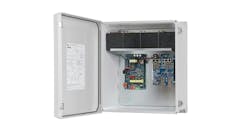Your Partner In Protection: THE CENTRAL STATION
My entry point into the alarm industry was during the era when tape dialers were slowly being phased out by the introduction of digital communicators. The majority of alarm communications were over POTS lines, with the high-end applications using leased lines.
Alarm technology tape dialers and leased lines afforded relatively limited reporting options. Dialers could offer only a limited number of messages: alarm, fire, panic. Leased lines provided faster connection speed since the whole dialing process was bypassed. The additional benefit of line supervision was that if a fault occurred on the wire connecting the premises with the monitoring station, it would show up and corrective actions could be taken, like call Ma Bell and ask them to figure out what went wrong with the lines.
My alarm activities involved dial-up accounts and almost exclusively digital dialers or alarm panels which came with integral digital communicators. A big transition back then was going from rotary to pulse dial.
It is interesting to note that there are still dialers on the market which deliver a voice message, only they use electronic means to accomplish this, not tape.
But even in its most rudimentary stages, digital alarm reporting offered significant advantages over the tape dialer. The variety of test and auxiliary signals, as well as per zone annunciation, were excellent.
Along with digital communicators came back-up reporting technologies which were used to supplement the telephone lines as a redundant means of contacting the central station.
After the first episode where an alarm customer complained that his other alarm went off but the police never showed up, I always incorporated some form of test signal into my accounts, and at least offered them the option of backup reporting.
Test signals and how they are managed varies from central station to central station, or from alarm panel to alarm panel.
The simplest is a daily signal sent on a regular interval. The central station is programmed to notify someone if they do not receive one or more of these signals within the predefined time ‘envelope.’
Most alarm panels have internal features which create an audible signal at the premises if the alarm panel attempts to communicate with the central station but is unable to do so, either because the panel does not detect a dial tone, or it is unable to reach the central station receiver and connect.
The loss of dial tone could mean anything: a cut wire on the premises, a downed utility pole, etc. On improperly installed alarms, no dial tone could be caused by the burglar deliberately taking a house phone out of its cradle, (off hook) preventing the alarm panel from dialing out. Note: the correct way to connect an alarm panel is thru a RJ-31X jack.
But the local on premises ‘failure to communicate’ feature didn’t work out well for me and my clients. One reason was that some of my accounts were vacation properties that were vacant most of the time. A downed telephone line causing a failure to communicate message in the premises was useless.
Also some clients were not technically oriented enough or couldn’t be bothered to deal with any noises coming out of their alarm panels. Hey it was Long Island in the Seventies, what can I tell ya’?
There were a lot of reasons an alarm communication might not get through to the central station on the first attempt, and alarm panels typically are programmed to make multiple attempts. By knowing that my alarm panels were regularly testing themselves and functioning and communicating with the central station gave me a warm indemnified feeling. At least we knew that part worked.
Openings and closings were another favorite. Sometimes the client wanted a printout (a written report), other times they just wanted to have the ability to retrieve the info when they had a need.
Again, the central station programmed the account to look for the system to be disarmed (an opening) or armed (a closing) according to a predefined schedule. Failure to either would typically cause a phone call to the business owner’s residence, an entry on their written report, or a phone call to me the dealer.
Alarm systems are not fun or glamorous. Most people resent them. The added value of knowing the comings and goings of their employees made a big hit with my customers who needed it.
There are also lots of other custom monitoring possible - flood sensors, freeze sensors; loss of line voltage, low battery in the alarm panel, ‘I’ve fallen and can’t get up alarms’ etc.
The vulnerability of the phone lines was a much publicized fact, especially by the alarm industry. But it was true. The point of demarcation - where the phone lines enter the premises and connect to the clients’ house wiring - was generally unprotected. Additionally, phone lines and dial tone on land lines are not 100 percent reliable. Stuff happens.
So I always offered the option of backup reporting to my clients. It was right there on the contract. If they declined to add backup reporting to their account, they had to initial the part that said they were offered but declined this feature.
Even with today’s many communications technologies, backup reporting is still a valuable feature for an alarm system.
These days, my favorite backup reporting technology uses cellular.
There are many contract monitoring services out there. They market themselves in many ways. The quality of service they render may also vary. If you do not know someone who can recommend a central station, contact the Central Station Alarm Association (440 Maple Avenue East, Suite 201, Vienna, VA 22180. Telephone: 703/242-4670. Web site: www.csaaul.org) for a listing of members.
In Virginia (and other states), the state regulates alarm dealers and central stations. So be certain you select a central who is licensed for your state.
As far as marketing promotions, some centrals advertise really low monthly monitoring rates to lure new dealers.
As far as I am concerned, it is more important to adequately protect my clients and my business than to save a few bucks on monitoring fees. For example, if a central offers basic monitoring deal without test for ‘cheap,’ I’d maybe look for another central station.
PARTNERSHIP
The central station is your partner, and you need to pick your partners wisely. I have picked my central stations using a number of different criteria, which include:
• A good reputation among fellow alarm association members
• How close they are geographically to the service area
• Types of panels they monitor
• Types of backup reporting technologies they support
• How they answer the phone when I call
• How they answer the phone when my customers calls in for help.
On-line support services are also important. It’s valuable to be able to check and alter your accounts’ status with your computer, or get a faxed/emailed alarm activity report every morning.
Access control, remote video surveillance and personal medical monitoring are emerging markets that incorporate contract central station services which you might want to look into as possible new revenue streams.
Due to the range of regulations that govern fire alarms, I’ve deliberately avoided mentioning smoke and heat detectors in the overview. Because in my jurisdiction, residential smoke and heat detectors were permitted, and I was able to purchase commercial insurance for this service, I usually included them in my systems. One fly in the ointment was that the building codes in the area required line voltage powered smoke detectors in new construction. This made for an awkward conversation with some clients.
Customer: “Why are you trying to sell me smoke detectors? I already got smoke detectors.”
Me: “But mine are better.”
Customer: “Why?”
Me: “For several reasons: Mine will be located throughout the premises adjacent to sleeping areas; they will be powered by the alarm system which has battery backup so they will continue to work if there is a power failure, and there are no batteries for you to replace. I will also put heat detectors in the attic the boiler room the garage and the kitchen which statistically are where most residential fires start. If one of my devices are triggered, the alarm will sound through out the house so you are sure to hear it and hopefully get out of the premises safely. And finally, my smoke and heat detectors contact the fire department when they alarm, so the fire department and emergency services will be notified immediately.”
Customer: “How much do I save if you don’t put in the fire?”
Me (thinking to myself) “This guy is worried about a few hundred bucks? Good Grief”
Tim O'Leary
Tim O'Leary is a security consultant, trainer and technician who has also been writing articles on all areas of locksmithing & physical security for many years.





